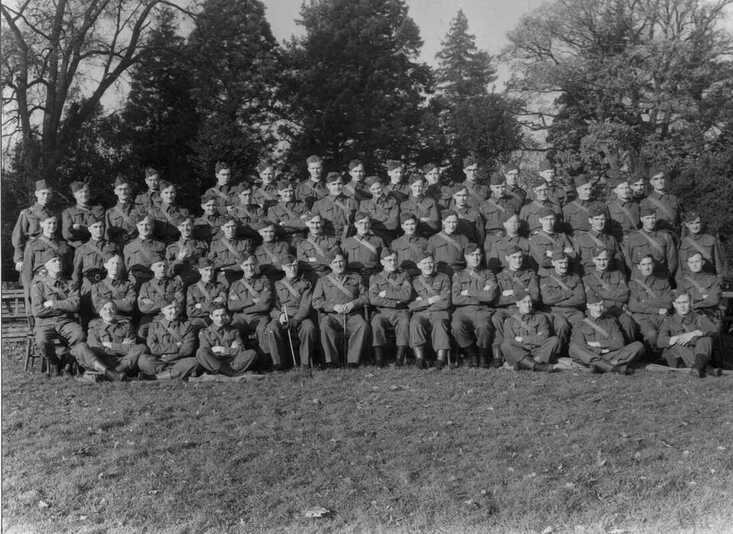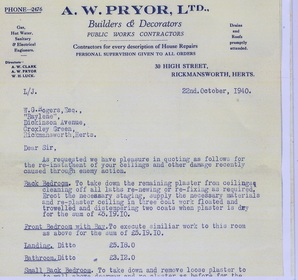Civil Defence
 Members of the Croxley Green Civil Defence volunteers.
Members of the Croxley Green Civil Defence volunteers.
As war broke out the Emergency Services began to appeal for volunteers to cover many aspects defending the countryside, towns and villages and was the responsibility of the Local Authority. Initially very little equipment and uniforms were available and ‘make do’ was the best on offer. This has been particularly highlighted with the Home Guard, originally called the Local Defence Volunteers and because many were passed uniformed men from WW1 and (some) advanced in years were humorously called ‘Dad’s Army’ However, LDV was changed to Home Guard and were to become a valuable asset and ready for action if required. Training was given depending on past experience to all the groups.
Croxley Green area map shows all the emergency service location- some still recognisable. A fire station at The Green end of Copthorne Road can still be seen but ‘change of use’ The First Aid Unit was at the top of Mill Lane near Frankland Road and now shops.
Croxley Green area map shows all the emergency service location- some still recognisable. A fire station at The Green end of Copthorne Road can still be seen but ‘change of use’ The First Aid Unit was at the top of Mill Lane near Frankland Road and now shops.
My late father William Hughes was in the Home guard from the start and remember going up to the Green with him to collect his LDV armband (the only bit of uniform available at the start!) as well as his rifle and bayonet. His was the unit based at Durrant OMT under command of Captain Hodson - a former officer who served after WW1 with the Black & Tans. The Unit was B company, 5th Battalion Herts. Regiment Home Guard. Dad was a Sergeant in the Home Guard until about 1944 when he took over the Army Cadets unit at Durrants School as a Lieutenant. (Jim Hughes)
As war broke out the Emergency Services began to appeal for volunteers to cover many aspects defending the countryside, towns and villages and was the responsibility of the Local Authority. Initially very little equipment and uniforms were available and ‘make do’ was the best on offer. This has been particularly highlighted with the Home Guard, originally called the Local Defence Volunteers and because many were passed uniformed men from WW1 and (some) advanced in years were humorously called ‘Dad’s Army’ However, LDV was changed to Home Guard and were to become a valuable asset and ready for action if required. Training was given depending on past experience to all the groups.
Croxley Green area map shows all the emergency service location- some still recognisable. A fire station at The Green end of Copthorne Road can still be seen but ‘change of use’ The First Aid Unit was at the top of Mill Lane near Frankland Road and now shops.
Croxley Green area map shows all the emergency service location- some still recognisable. A fire station at The Green end of Copthorne Road can still be seen but ‘change of use’ The First Aid Unit was at the top of Mill Lane near Frankland Road and now shops.
Below are reproduced copies of hard to read originals from the 8th Battalion Home Guard number 4 platoon Scots Bridge and covering Croxley Green showing briefing pages for "Standing Orders", "Stand To Orders" and "Action Station Orders". Platoon Headquarters were at 86 Watford Road and it is also interesting to see that cars taken off the road were immobilised and placed under trees in Croxley Woods.
Your browser does not support viewing this document. Click here to download the document.
Below is a reproduced copy from a hard to read original of Air Raid Alerts and Resulting Damage in the Rickmansworth area. It was painstakingly recorded by a
Mr. A. Pebbles, Chief Warden 1939 - 1945 with the approval of T.J. O'Sullivan, Controller of A.R.P. Rickmansworth.
Mr. A. Pebbles, Chief Warden 1939 - 1945 with the approval of T.J. O'Sullivan, Controller of A.R.P. Rickmansworth.
Your browser does not support viewing this document. Click here to download the document.
Memeories of WW2, Bombs and Air Raids by John Durrant
John Durrant remembers Croxley Green during the war, and remembered the bomb that seriously damaged All Saints Church. He said "The Blitz had been buzzing away from when the evenings got darker in 1940 and surprisingly one had got used to the searchlights beaming away, the drone of unsynchronised Dornier and Heinkel engines and the crack of AA guns feeling for them.
"Perhaps we had got blasé but at 15or 16 years old, one is indestructible. Sometimes there was the distant crump of a bomb but that was to be someone else's story. Then about 11pm one November night (I think it was November) we had just gone to bed at 127 New Road - my parents under the stairs, me behind the sofa - when there were two enormous bangs from the direction of the Green. "A quick check of our shop window glass, of Wade's, the newsagent next door and the other shops nearby showed they were OK. But it was not until early next morning, when I got my bicycle out, that ground zero could be located.
"It had been two parachute mines, one landing in the woods just behind what was then the Vicarage, the other hitting a house on the slip road behind the church. No official was about, so in I went to the church to see a mass of broken glass and general confusion - it was not until later that morning that 'no entry' signs appeared.
"Venturing round the slip road revealed a devastated house with ARP personnel busily working. The warden's post and underground shelter close by, on the Green, appeared undamaged, although rumour had it that an on-duty warder standing outside at the time was unhurt. In fact I believe that no-one was hurt in either explosion.
"Next, off I went down the lane (as was) beside the vicarage into the woods where, close to the back of the vicarage garden, were the now leafless trees that still held the remains of the parachute. The Vicarage itself has lost most of its glass and many slates.
"I went back to the slip road and looking up at the tower, I could see that two of the three clock dials had been pushed in and the hands told the time of the event. Why is it that one does not record these details at such times?
"In due course, many months later, the church was made useable again and one face of the tower made to give the time once more, under the direction of my father, EB Durrant. "In fact, I was with him when it first struck again - and saw a small group of people staring up in surprise - remember that the sound of a church bell was the signal' of invasion. "Until well into the 1960s he, as a labour of love, kept the clock wound and maintained, as have many others before and since. .
A little while later, another small stick of bombs totally destroyed the row of cottages that stood by the Met Station. "There were several other incidents but well out of the village in the fields in the direction of Sarratt, but no doubt someone knows about those. "It was an exciting, if dangerous, time to be alive, but we were all very much 'together'."
"Perhaps we had got blasé but at 15or 16 years old, one is indestructible. Sometimes there was the distant crump of a bomb but that was to be someone else's story. Then about 11pm one November night (I think it was November) we had just gone to bed at 127 New Road - my parents under the stairs, me behind the sofa - when there were two enormous bangs from the direction of the Green. "A quick check of our shop window glass, of Wade's, the newsagent next door and the other shops nearby showed they were OK. But it was not until early next morning, when I got my bicycle out, that ground zero could be located.
"It had been two parachute mines, one landing in the woods just behind what was then the Vicarage, the other hitting a house on the slip road behind the church. No official was about, so in I went to the church to see a mass of broken glass and general confusion - it was not until later that morning that 'no entry' signs appeared.
"Venturing round the slip road revealed a devastated house with ARP personnel busily working. The warden's post and underground shelter close by, on the Green, appeared undamaged, although rumour had it that an on-duty warder standing outside at the time was unhurt. In fact I believe that no-one was hurt in either explosion.
"Next, off I went down the lane (as was) beside the vicarage into the woods where, close to the back of the vicarage garden, were the now leafless trees that still held the remains of the parachute. The Vicarage itself has lost most of its glass and many slates.
"I went back to the slip road and looking up at the tower, I could see that two of the three clock dials had been pushed in and the hands told the time of the event. Why is it that one does not record these details at such times?
"In due course, many months later, the church was made useable again and one face of the tower made to give the time once more, under the direction of my father, EB Durrant. "In fact, I was with him when it first struck again - and saw a small group of people staring up in surprise - remember that the sound of a church bell was the signal' of invasion. "Until well into the 1960s he, as a labour of love, kept the clock wound and maintained, as have many others before and since. .
A little while later, another small stick of bombs totally destroyed the row of cottages that stood by the Met Station. "There were several other incidents but well out of the village in the fields in the direction of Sarratt, but no doubt someone knows about those. "It was an exciting, if dangerous, time to be alive, but we were all very much 'together'."





















